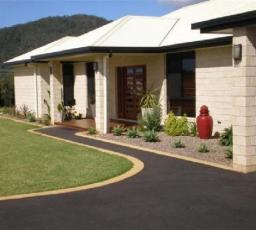Search
Login
How to put asphalt in front of the house with your own hands
Mass construction of cottages and summer cottages is inextricably linked with the improvement of the territory. Of course, the paramount task, upon completion of construction, is to improve the entrance and path to the house, since moving knee-deep in mud on a rainy day is far from an attractive prospect. At the same time, laying tiles is quite an expensive and time-consuming task, concreting a relatively short-lived future, but laying asphalt, the price of which is significantly lower than paving slabs, is an attractive option, and the laying process is quite simple, so asphalting the territory yourself will not cause any special difficulties. The main thing is to choose the right type of asphalt and observe the technology of its laying.
Content
- The benefits of asphalt
- Asphalt and its types
- Varieties of artificial asphalt, their characteristics
- Asphalt Paving Technology
The benefits of asphalt
Despite the relative environmental friendliness of asphalt mixtures, the demand for this material is unlikely to come to naught, since the advantages of asphalt in many ways surpass most of the similar materials, including:
- Excellent waterproofing;
- It does not deform under sharp temperature fluctuations;
- High degree of wear resistance;
- Moisture resistance;
- Resistance to oils, acids;
- Lack of laborious care;
- Ease of repair of damaged areas;
- Duration of operation;
- Practicality;
- Reasonable cost.
Among the disadvantages of asphalt mixtures, the unpleasant odor that appears in hot weather due to the release of toxic substances by a hot coating is of no small importance, although in most cases this nuance is simply omitted.
However, the manifestation of all the advantages of asphalt pavement is possible only when you precisely possess complete information on how to put asphalt in the yard. Based on this, the initial task is to choose the right type of asphalt in relation to the conditions for its future operation.
Asphalt and its types
Asphalt is a combination of mineral materials with bitumen. Depending on the method of its production, asphalt is released:
- Natural origin. The formation of asphalt occurs under the influence of oxidation and hypergenesis of heavy oil fractions or light components obtained from the fractions residues during the evaporation process, followed by mixing with sand, gravel, forming rather powerful layers on the surface. This type of asphalt is widely used in areas of oil exit to the surface.
- Artificial origin. Asphalt obtained by mixing sand, gravel, and mineral powder with bitumen in the factory, is called asphalt concrete, through which the main asphalting of roads, sidewalks, etc.

The main difference between natural asphalt and artificial asphalt is due to the high content of bitumen in the composition of mixtures, reaching 60-75%, which provides increased strength to the laid asphalt. In artificial asphalt, the percentage of bitumen varies from 13-60%, which explains its division into several subspecies used for various works and areas of destination.
Varieties of artificial asphalt, their characteristics
Recently, the demand for asphalt products has increased markedly, so manufacturers are constantly striving to improve the technological composition of raw materials and the method of its manufacture, which entails the emergence of new types of asphalt.
To date, the following types of asphalt are produced:
1. Hot is made from a composition including sand, mineral powder, liquid, or viscous bitumen, as well as crushed stone or gravel. Under the influence of high temperatures, all components are thoroughly mixed, forming a homogeneous mass. In this case, asphalt laying is carried out immediately, within 4-5 hours from the date of manufacture of a certain volume. If the temperature of the mass drops below 120 C, then the degree of adhesion will decrease, impairing the quality of the coating.

Benefits:
- High strength hardened coating;
- High adhesion to the surface;
- Durability;
- Reasonable cost.
Disadvantages:
- To seal the coating, the use of rollers, vibrating plates;
- Efficiency of work to prevent cooling of the asphalt mass;
- You can only operate after 5-6 hours;
- The ability to work in warm weather.
2. Cast, along with hot asphalt, has a similar composition, but is characterized by a high content of bitumen and mineral fillers. Paved asphalt concrete pavement differs from other types by insignificant relief and small layer thickness, while operational characteristics are several times higher than those of hot and cold asphalt.

Benefits:
- Excellent water resistance
- No material corrosion;
- Resistance to various deformations;
- High adhesion to the coated surface;
- Coating seal is not required;
- Resistance to temperature fluctuations;
- Year-round work;
- Light weight due to the high density of the mixture;
- Durability.
Disadvantages:
- The use of special equipment, delivering and laying the finished mixture;
- High price.
3.Color can relate to both hot asphalt and cold, produced by heating the components, followed by cooling and packaging for storage. Colored asphalt is obtained by using colored gravel, as well as the introduction of colored dyes into the mixture.
Advantages:
- Excellent sound absorption;
- High adhesion with rubber;
- In the dark, the color track is visible much better than the gray;
- Durability.
However, due to the high cost, colored asphalt is used mainly for applying a contrasting pattern to the road, for marking paths in parks and gardens.
4. Cold is distinguished by using not viscous but liquid bitumen or bitumen emulsion in the composition so that the constituent elements of the mixture are packed in a bitumen film. During production, special additives are introduced into the mixture that prevent the curing of bitumen during storage of the finished mixture, as well as increase the storage time.

Pros:
- The polymerization process begins at the time of tamping the coating;
- On paved asphalt, you can immediately move around, ride;
- Resistance to expansion, shrinkage caused by weather conditions;
- Possibility of carrying out all-season work;
- The minimum content of harmful substances;
- Speed \u200b\u200bof laying;
- Durability.
Minuses:
- Manual tamping of the coating is required, or with the use of a roller;
- High cost compared to hot types of asphalt.
5. Asphalt chips are recyclables resulting from:
- Milling obsolete asphalt topcoat. The cost, along with the quality obtained in this way crumbs, directly depends on the composition of the processed asphalt mixture and the speed of the cutter. The highest quality is considered warm asphalt crumb, consisting of a fine fraction. However, the material can only be purchased in the warm season, when repairs are being carried out.

- Crushing of pieces breaking away from the asphalt pavement. The chips entering the production are crushed in a crusher, as a result of which the asphalt crumbs are immediately sorted by the size of the fraction. During processing, bitumen remains in a frozen state, as a result of which the coating with such a crumb will have a somewhat loose structure. In addition, asphalt chips can come with adhered pieces of concrete, soil, worsening the quality of the processed material.
Thus, the quality and cost of asphalt chips after milling exceeds the performance of the material obtained by crushing.
In general, laying asphalt using crumbs is simple, as a result of which the coating acquires the following advantages:
- It is not washed away by water;
- Under the influence of the sun, bitumen liquefies, contributing to the sintering of the composition;
- Provides good drainage performance;
- Low cost.
Disadvantages:
- To give the coating strength, it is necessary to use a rolling device;
- Fragility.
Despite the variety of asphalt mixtures, one and the same type can have different purposes, depending on the size of the fractions included in it:
- Coarse-grained asphalt is characterized by the presence of large as well as fine fractions in the crushed stone composition and is intended for laying as a lower coating layer;

- Fine-grained based on crushed stone, mainly fine fractions for laying the top layer of the coating, using a multilayer coating intended for the roadway;

- Sandy asphalt, the basis of which is sand, with the addition of a small amount of crushed stone of fine fraction, bitumen and mineral powder. Ideal for arranging paths, paths, park areas.

Thus, choosing one or another type to put asphalt in the country, in the yard or near the garage, it is necessary to pay attention not only to the financial side of the issue, but also to the composition and the method of production of the mixture.
Asphalt Paving Technology
After choosing the type of asphalt, answering the question of how to lay asphalt with your own hands is already quite simple, since it remains to prepare the foundation and make the direct laying of the mixture.
foundation preparation
Before laying asphalt, the following work must be done:
- Mark the future path or territory, taking into account the location of underground utilities, the distance to the installation of borders, as well as the presence of trees with a developed root system, which in the future can damage the coating;
- Remove the soil layer to a depth of 20-30 cm, making a slope for water flow from the coating by 6-7 mm through each meter;
- Install a curbstone along the edges of the trench;
- At the bottom of the trench, pour crushed stone, or gravel, with a layer of 10 cm and tamp;
- On top of the rubble, with a layer of 5 cm, fill in the sand and also thoroughly tamp, pre-moistened with water.
If the territory will be used for the arrival of transport, then the layer of rubble and sand needs to be increased by another 10 cm.
asphalt mixing
Direct laying of asphalt is carried out as follows:
- Distribute the brought mixture around the entire perimeter of the territory intended for asphalting using a shovel and a tool specially designed for leveling in the form of a mop;
- Compaction of the leveled layer by means of a skating rink, a vibrating plate, or manual tamper. At the same time, so that the asphalt does not stick to the roller, it must be moistened with water;
- Rolling of the asphalt layer occurs from the bottom up, and then perpendicularly to remove the formed seams.
If the path is paved, then a sufficient coating layer is 4-5 cm, and if transport will enter the territory, then 8-10 cm.
Thus, the question of how to properly lay the asphalt can be answered as follows: choose the type of asphalt, observe the technology of preparation of the foundation and lay the asphalt coating. It is also worth noting that a slight deviation from some points of technology can lead to the loss of asphalt of its properties and a shorter lifespan.





